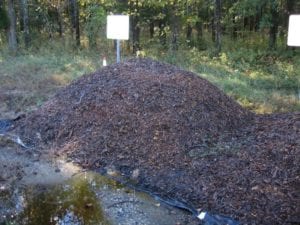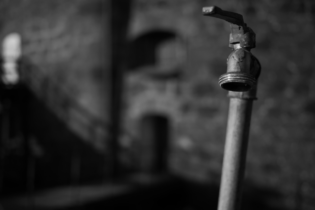Novel approach to carcass disposal
Dr Melanie Jones, a veterinarian based in Cape Town and founder of Zero to Landfill Organics, is running a trial on the composting of companion animal carcasses that are currently being taken to landfill. These carcasses become hazardous waste, particularly when infectious, which in turn is also the challenge to the possibility of composting. Yanna Erasmus investigates. While there are no official figures available, it is not rocket science to figure out that there are thousands of companion animal carcasses that are not incinerated by owners that must be disposed of in South Africa every year. A contractor that landfills animals in Cape Town estimates that around 2 000 carcasses are landfilled monthly in that city. This excludes those animals that die or are euthanised at veterinarians in the city. These animals, including those from veterinarians which are not incinerated, are placed in special disposal bags and are taken to landfill. According to Jones: “The sizes of animals also vary greatly from 60 kg Rottweilers to 200 g puppies or kittens. The City of Cape Town is also landfilling whales and seals that are washed up on the beaches.” This may still be a novel concept in South Africa, but in both Canada and the US, road-killed wild animals have been composted for some time. According to an article published in BioCycle in November 2006, over 25 000 deer are killed on New York State highways every year in addition to like raccoons, coyotes and foxes. Pioneered by Cornell University’s Waste Management Institute in the early 2000s, these animals have been composted in various ways including static pile composting with wood chips. This has been rather successful as the temperatures achieved in the piles is sustained long enough and is high enough to generally kill the pathogens present. More research is being done into this issue by the university. Pennsylvania State University has also performed its own research and both institutions have worked out a basic and relatively simple procedure. They advise that a well-drained site at least 200 feet from a water source is ideal. Woodchips and sawdust is then spread out in a windrow format, around five to seven feet wide. The animal is then placed on the sawdust in the centre of the row. One foot of sawdust is then placed between each animal and the next is then layered until the pile is around six feet high. A two-foot cover of sawdust or compost is then placed on top. After three to five months the pile can be turned. A 25:1 ratio of sawdust to animal (carbon to nitrogen) is ideal. If the pile becomes too wet, more sawdust and woodchips must be added. This sounds rather simple, but the quest to divert companion animal carcasses from landfill is far more complicated, particularly in South Africa. By far the bulk of companion animals that are landfilled are unwanted and uncared for. Hence, the presence of parvo and distemper viruses is commonplace and bacteria such as Salmonella and E. coli must be also eliminated. Jones adds helminth eggs and the breakdown of pentobarbitone, the drug used to euthanise the animal, to this list. Jones has been running a small-scale trial in Cape Town. “Regarding our trial, the first animals that were composted have been reduced to bones and hair. There is very little flesh left and odour is minimal when the heap is opened. We are still experimenting with different carbon sources – wood chips, garden refuse and sawdust, for example. We have divided the animals into different heaps to see what the best method of composting is. Due to the large amount of leachate the second heap has been built on plastic sheeting with sawdust around the edges to soak up the leachate. “I have been talking to UCT and the toxicology department at Onderstepoort about the testing of both the soil under the compost heap and the compost heap itself for drug residues. The trial is very small at the moment and ideally we would like to change to in-vessel composting once we can prove that the drug residue and pathogens will not be a problem and we can scale up the volumes. Unfortunately all the studies I have found from overseas are based on livestock or animals killed on roads as they don’t have South Africa’s problem of thousands of unwanted or diseased dogs and cats that are euthanised every year, so this study seems to be unique in the fact that companion animals are being composted. I am busy preparing a paper on our processes to document our findings and results; I’m not sure how long it will take to get the process right and determine the optimal composting conditions.” In a study performed by Cornell on the decay rate of drugs including pentobarbital, a comparison was made between burial and composting. In both cases, the drug had fully decayed by three months, although with the composting site it was picked up in the leachate. The conclusion, however, is: “When done properly, mortality composting protects ground- and surface water and composting of euthanised livestock appears to break down pentobarbital and phenylbutazone, thus rendering the finished product safe for wildlife and domestic use.” Best practice, as listed by Cornell, include that carcasses must be added in a timely fashion with lumens lanced; the piles must be well shaped, neat and not too big; and that ground- and surface water protection are paramount. The latter can be achieved by using compost berms, filter strips, diversion berms, collection lagoons and tanks, and keeping the site mowed and clean. Expert opinion The National Draft Healthcare Risk Waste (HCRW) Management Regulations state that no person may treat anatomical and isolation waste in a technology other than incineration. Anatomical waste also includes “deceased animals or animal parts infected with zoonotic diseases and includes an animal kept at a laboratory for the purposes of biological or scientific research and testing, but excludes human teeth, hair and nails, and animal carcasses regulated by the Animal Health Act (Act No 7 of 2002)”.In light of this, RéSource spoke with Kobus Otto of Kobus Otto & Associates, an expert in healthcare waste, based in Kempton Park.
How do these remains affect water courses/resources? There is a risk of surface- and groundwater pollution in the event of the mortal remains being infectious. A risk assessment is therefore required in all instances where such remains are not incinerated or disposed of on legally compliant landfills. Persistent viruses such as distemper and parvo virus are prevalent in South Africa with unwanted pets.In your opinion, are these very dangerous for our environment and how? Persistent viruses can result in animal anatomical waste being infectious. Animals from road-kill incidents are in most instances not well-maintained and inoculated pets, but are stray animals that are not looked after by its owners. Well-cared for pets also get killed on roads, but most pets killed on roads are in the vicinity of low-income residential areas.It is not viable to test any remains from animals killed on roads to determine whether the remains are infected with any diseases or not. As an expert, are you concerned about the high number of euthanised pets that are wrapped in black bags and being disposed of in landfills? No. I see safe disposal of euthanised pets on legally compliant landfills as an environmentally sound way of reducing the spread of infections from such animals. With the upcoming standards for emissions from incinerators being very high, the costs associated with incineration of unwanted pet carcasses is very high and not affordable to the majority of people in South Africa. This is recognised by the Draft Standards for Disposal of Waste to Landfill that specifically provide for the disposal of non-infectious animal carcasses to Class B landfills. There are, however, certain procedures to be followed for disposal of non-infectious animal carcasses to ensure that it is not exposed on the surface where it can spread diseases (that may not have been detected) or create a nuisances like odours, vectors or rodents. Animal carcasses arriving on site should either be disposed of in trenches excavated into the waste before being covered with waste, or alternatively it should be disposed of at the toe of the waste disposal working face, with the very next waste load being disposed of on top of the carcasses before the waste is compacted and covered with soil as part of the standard landfill operations procedures. Any personal thoughts you would like to share? My personal view is that there is vast amounts of organic waste currently still disposed of on landfills that can be recovered for composting before we need to go the route of composting animal remains. If it is a matter of finding a means of disposing of animal remains, the draft HCRW Regulations makes provision for the incineration of infectious animal carcasses, while the draft Standards for Disposal of Waste to Landfill provides for the disposal of uninfected carcasses. Should infected carcases accidentally arrive on a landfill, the procedure for proper disposal of the carcasses together with the comprehensive landfill lining system will limit the potential risk to the environment. Some experts in the waste industry agree. Most spoken to are of the opinion that there would be resistance from animal rights groups to mortality composting with companion animal carcasses and that the market for the compost would have to be industrial as opposed to the private consumer.In the absence of mass incineration, which is becoming more and more expensive, responsible landfilling remains the best option.In the absence of subsidised incineration options and with a focus of the diversion of waste from landfill, composting of animal remains can be viable, if good management practices are applied.







